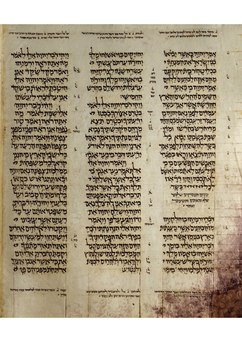Loading AI tools
Book of Jeremiah, chapter 27 From Wikipedia, the free encyclopedia
Jeremiah 27 is the twenty-seventh chapter of the Book of Jeremiah in the Hebrew Bible or the Old Testament of the Christian Bible. The material found in Jeremiah 27 is found in Jeremiah 34 in the Septuagint, which orders some material differently. This book contains prophecies attributed to the prophet Jeremiah, and is one of the Books of the Prophets. The New American Bible (Revised Edition) (NABRE) describes chapters 27-29 as "a special collection of Jeremiah’s prophecies dealing with false prophets", and suggests that "stylistic peculiarities evident in the Hebrew suggest that these three chapters once existed as an independent work".[1]
| Jeremiah 27 | |
|---|---|
 A high resolution scan of the Aleppo Codex showing the Book of Jeremiah (the sixth book in Nevi'im). | |
| Book | Book of Jeremiah |
| Hebrew Bible part | Nevi'im |
| Order in the Hebrew part | 6 |
| Category | Latter Prophets |
| Christian Bible part | Old Testament |
| Order in the Christian part | 24 |
The original text was written in Hebrew language. This chapter is divided into 22 verses.
Some early manuscripts containing the text of this chapter in Hebrew are of the Masoretic Text tradition, which includes the Codex Cairensis (895), the Petersburg Codex of the Prophets (916), Aleppo Codex (10th century), Codex Leningradensis (1008).[2] Some fragments containing parts of this chapter were found among the Dead Sea Scrolls, i.e., 4QJerc (4Q72; 1st century BC),[3] with extant verses 1‑3, 13‑15 (similar to Masoretic Text).[4][5][6]
There is also a translation into Koine Greek known as the Septuagint (with a different chapter and verse numbering), made in the last few centuries BCE. Extant ancient manuscripts of the Septuagint version include Codex Vaticanus (B; B; 4th century), Codex Sinaiticus (S; BHK: S; 4th century), Codex Alexandrinus (A; A; 5th century) and Codex Marchalianus (Q; Q; 6th century).[7]
The parashah sections listed here are based on the Aleppo Codex.[8] Jeremiah 27 is a part of the Tenth prophecy (Jeremiah 26-29) in the section of Prophecies interwoven with narratives about the prophet's life (Jeremiah 26-45). {P}: open parashah; {S}: closed parashah.
The order of chapters and verses of the Book of Jeremiah in the English Bibles, Masoretic Text (Hebrew), and Vulgate (Latin), in some places differs from that in Septuagint (LXX, the Greek Bible used in the Eastern Orthodox Church and others) according to Rahlfs or Brenton. The following table is taken with minor adjustments from Brenton's Septuagint, page 971.[9]
The order of Computer Assisted Tools for Septuagint/Scriptural Study (CATSS) based on Alfred Rahlfs' Septuaginta (1935), differs in some details from Joseph Ziegler's critical edition (1957) in Göttingen LXX. Swete's Introduction mostly agrees with Rahlfs' edition (=CATSS).[9]
| Hebrew, Vulgate, English | Rahlfs' LXX (CATSS) |
|---|---|
| 27:1,7,13,17,21 | none |
| 27:2-6,8-12,14-16,18-20,22 | 34:2-6,8-12,14-16,18-20,22 |
| 50:1-46 | 27:1-46 |
This verse is absent from the Septuagint.[11] In place of Jehoiakim, the English Standard Version, NABRE, New International Version and Revised Standard Version refer to Zedekiah.[12] The New American Bible (Revised Edition) advises that "the Hebrew text actually has “Jehoiakim”, but the content of the chapter indicates that Zedekiah is intended.[13]

Seamless Wikipedia browsing. On steroids.
Every time you click a link to Wikipedia, Wiktionary or Wikiquote in your browser's search results, it will show the modern Wikiwand interface.
Wikiwand extension is a five stars, simple, with minimum permission required to keep your browsing private, safe and transparent.